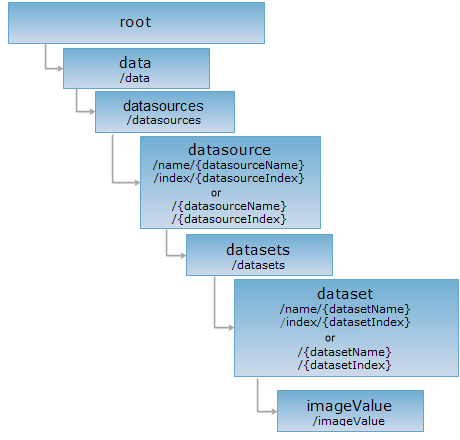URI
<dataset_uri>/imageValue[.<format>]
Supported methods
Parent resource
Introduction
imageValue indicates the pixel information value of image dataset. Through sending get request to imageValue, you can query the pixel value information corresponding with a location, which includes band value, image row, image column, color and so on.
Supported Methods:
- GET: Gets the pixel value information corresponding with a location.
- HEAD: Checks whether the imageValue resource exists or whether it has permission to access the resource.
Supported output formats: rjson, json, html, xml.
Resource hierarchy

HTTP request methods
Implement the HTTP request on the following URI, where supermapiserver is the server name, with rjson being the output format.
http://supermapiserver:8090/iserver/services/data-World/rest/data/datasources/World/datasets/WorldEarth/imageValue
GET request
Gets the pixel value information corresponding with a location.
Request parameter
To acquire image information through implementing the GET request on imageValue resource, following parameters can be included in the URI:
| Name | Type | Description |
| X coordinate | double | The x-coordinate of location |
| Y coordinate | double | The y-coordinate of location |
Response structure
The structure of the response resource representation after implementing the GET request on the imageValue resource will be as follows:
| Field | Type | Description |
| bounds | int[ ] | Band value. Non-true color image, returning the value |
| color | Color | Indicates color value by RGBA. This value is returned when it is a 24-bit or 32-bit true color image. |
| column | int | The column number of the pixel. |
| row | int | The row number of the pixel. |
| value | int | Color value, using integer data representation. This value is returned when it is a 24-bit or 32-bit true color image. |
Response example 1
The information of color value is returned for a 24-bit or 32-bit true color image. Such as: getting the pixel information of WorldEarth dataset. Sendding get request to imageValue resource: http://supermapiserver:8090/iserver/services/data-world/rest/data/datasources/World/datasets/WorldEarth/imageValue.rjson?x=-110&y=50, the description in rjson is as follows:
{
"bounds": null,
"color": {
"alpha": 255,
"blue": 42,
"green": 72,
"red": 77
},
"column": 398,
"row": 227,
"value": 5064746
}
Response example 2
The band value bounds is returned for the image of other pixel format. Such as: getting the pixel information of worldimage dataset. Sendding get request to imageValue resource: http://supermapiserver:8090/iserver/services/data-world/rest/data/datasources/World/datasets/worldimage/imageValue.rjson?x=-110&y=50, the result is as follows:
{
"bounds": [
233,
227,
198
],
"color": null,
"column": 2099,
"row": 1199,
"value": 0
}
HEAD request
Asks for the response identical to the one that would correspond to a GET request, but without the response body. This is useful for retrieving meta-information written in response headers, without having to transport the entire content. The meta-information includes the media-type, content-encoding, transfer-encoding, content-length, etc.
HEAD request can be used to check if the imageValue resource exists, or if the imageValue resource can be accessed by clients. It can also determine if the imageValue resource supports an output format <format> if performed on a URI with .<format> included.